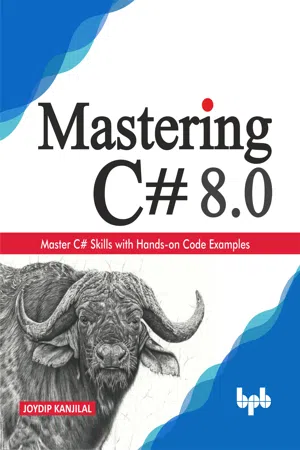
- English
- ePUB (mobile friendly)
- Available on iOS & Android
About this book
Step-by-step guide written in a lucid language for mastering C# Key Features
- Packed with plentiful code examples
- A comprehensive guide to mastering C#
- Discusses the OOP principles
- Targets beginner to advanced readers of C#
- Provides insight into the latest features of C#, including C# 8.0
- Covers Visual Studio 2019
Description
This book starts by introducing the concepts of.NET framework. It then discusses OOP and explores how one can work with OOP in C#. There are two chapters on OOP: the first one covers the basics of object-oriented programming (OOP); and the second one delineates advanced concepts related to OOP and how they can be implemented in C#.Next, the book discusses Language Integrated Query (LINQ) and how to work with it in C#, followed by multithreading, asynchronous and parallel programming concepts with relevant code examples to illustrate the concepts covered. Generics, collections, generic collections, delegates, lambda expressions are also covered in this section.In the last section of the book, serialization, file I/O and how to work with them in C# are discussed concisely. A separate chapter on C# 8.0 is added to highlight its new features... There is an appendix chapter as well that discusses how one can get started working with Visual Studio 2019. What you will learn
By the end of reading this book, the reader will have mastered the concepts of C# programming language, and be able to build high performance, scalable and robust applications using C#. Who this book is for
This book is intended for people who are aspiring a career in.NET as well as for professionals who would like to master the concepts of C# programming language. Since this book is for beginner to advanced readers of C#, a basic knowledge of C# will be helpful. Table of Contents
1. Microsoft.NET Internals
2. Getting Started with C#
3. Object-oriented Programming - Part 1
4. Object-oriented Programming - Part 2
5. Properties and Indexers
6. Programming LINQ in C#
7. Generic Collections in C#
8. Delegates and Extension Methods
9. Exception Handling in C#
10. Asynchrony and Parallel programming
11. Multithreading in C#
12. File I/O and Serialization
13. Advanced Concepts in C#
14. New Features of C# 8.0
15. Appendix About the Author
Joydip has been the Microsoft Most Valuable Professional (MVP) in ASP.NET, consecutively for six years (2007 to 2012). With more than two decades of industry experience and 16 years of experience in Microsoft.NET, he has authored eight books and reviewed more than a dozen books. Besides, he has written more than 500 articles in leading journals and websites, including MSDN, Code Magazine, InfoWorld, SSWUG, TechTarget Inc, etc. Your Blog links: https://www.infoworld.com/blog/microsoft-coder/
Your LinkedIn Profile: https://in.linkedin.com/in/joydipkanjilal
Frequently asked questions
- Essential is ideal for learners and professionals who enjoy exploring a wide range of subjects. Access the Essential Library with 800,000+ trusted titles and best-sellers across business, personal growth, and the humanities. Includes unlimited reading time and Standard Read Aloud voice.
- Complete: Perfect for advanced learners and researchers needing full, unrestricted access. Unlock 1.4M+ books across hundreds of subjects, including academic and specialized titles. The Complete Plan also includes advanced features like Premium Read Aloud and Research Assistant.
Please note we cannot support devices running on iOS 13 and Android 7 or earlier. Learn more about using the app.
Information
CHAPTER 1
The Microsoft .NET Ecosystem
Structure
- Introduction to Microsoft .NET
- Common Language Runtime
- Framework Class Library
- Common Language Specification
- Common Type System
- Common Intermediate Language
- Components of Microsoft .NET Framework
- Garbage collection
- The Dynamic Language Runtime
Objective
- Understand the components of .NET Framework
- Learn how the garbage collector works in .NET.
- Understand why the Common Intermediate Language is needed
- Understand the Dynamic Language Runtime
Introduction to Microsoft .NET
- Portability
- Cross-Language Integration
- Interoperability
- Base Class Library
- Security
Evolution of .NET framework

- .NET Framework 4.6: This version introduces new features and enhancements in cryptography, ADO.NET, WPF, profiling, NGen, and Windows Workflow Foundation (WWF).
- .NET Framework 4.7: This version introduces new features and enhancements in base classes, networking, ASP.NET, Windows Communication Foundation (WCF), Windows Forms, and Windows Presentation Foundation (WPF).
- .NET Framework 4.8: This version introduces new features and enhancements in the areas ofbase classes, WCF, WPF, and Common Language Runtime (CLR).
Common Language Runtime
- Just-in-time compilation
- Garbage collection
- Code access security
- Memory management
- Code verification

Common Intermediate Language

Dynamic Language Runtime

Framework Class Library
- File handling
- Exceptions
- Remoting
- Sockets
- Database access
- XML
- Web services
Common Type System
Value types and reference types
char, int, and etc, are examples of value types. Other examples of value types include: struct and enum. Refer to Figure 1.5 for better understanding:
boolbytechardecimaldoubleenumfloatintlongsbyteshor...
Table of contents
- Cover Page
- Title Page
- Copyright Page
- Dedication
- About the Author
- About the Reviewer
- Acknowledgement
- Preface
- Errata
- Table of Contents
- 1. The Microsoft NET Ecosystem
- 2. Getting started with C#
- 3. Object-Oriented Programming–Part 1
- 4. Object-Oriented Programming –Part 2
- 5. Properties and Indexers in C#
- 6. Programming LINQ in C#
- 7. Generic Collections in C#
- 8. Delegates, Funcs and Actions in C#
- 9. Exception Handling in C#
- 10. Asynchrony and Parallel Programming in C#
- 11. Multithreading in C#
- 12. File I/O and Serialization in C#
- 13. Advanced Concepts of C#
- 14. New Features in C#8.0
- 15. Getting Started with Visual Studio 2019
- Index